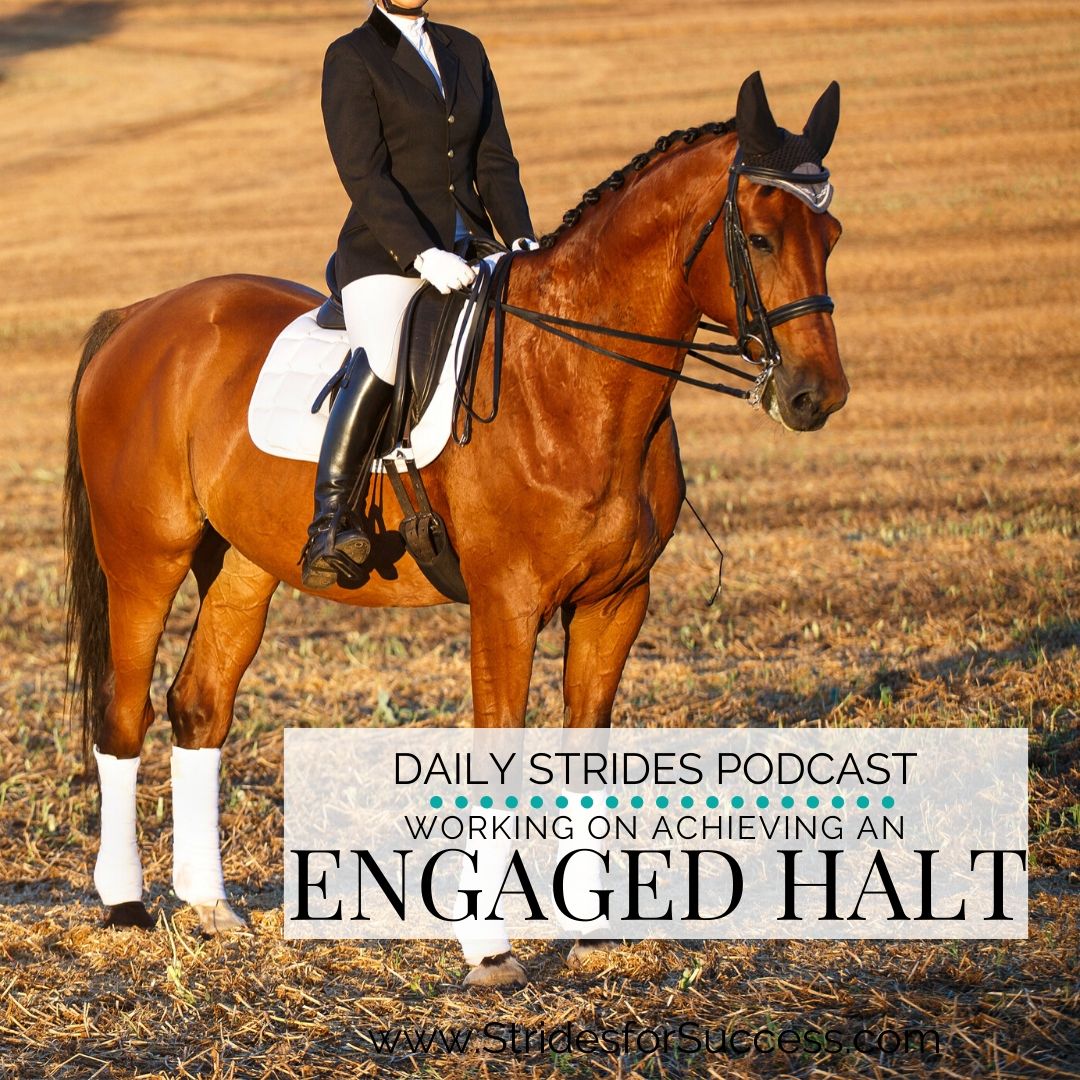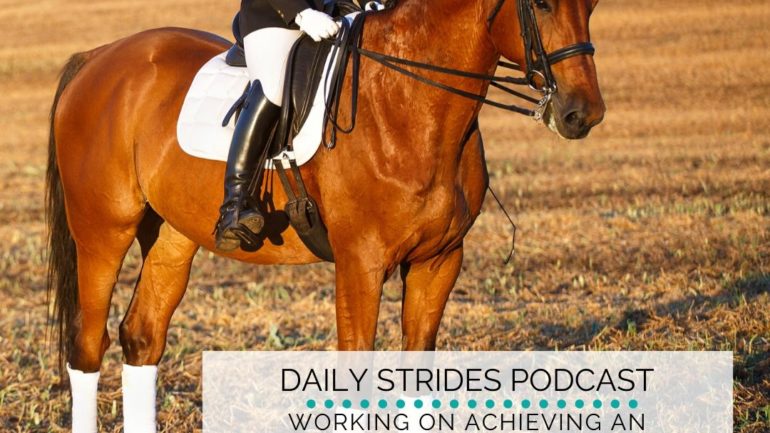
Quick question… If you were to guess, how many times did you halt throughout your last ride on your horse? Was it a ‘one time only’ event? Or perhaps you halted two or three times throughout the ride? Or was it into the double digits? Once you have that number, here’s another question. How many of those halts was the actual ‘end’ of the ride?
So many riders treat all halts the same. They see the halt as being the end of a moment or a sequence of movements, however, it rarely is. In fact, there is only one lat that actually signals the end, the last one. All the others are part of the ride and should be seen as an important exercise. Yep, every single halt.
in today’s episode of the Daily Strides Podcast, we are diving into all things ‘halt’. But not just any old halt; I want you to use this information, starting on your very next ride, to begin working on developing a more engaged halt for you and your horse.
I want you to be able to keep the energy you already have as you approach the halt contained through halt and then allow that energy to carry you into your next movement.
Why a Good Quality Halt is Important
We halt a lot every day when we are working with our horses. This is true regardless of if we are on the ground leading or lunging, or in the saddle riding. And often we pay a lot of attention to how we are transitioning in and out of the halt. However, the halt itself also demands attention and focus if it is to truly serve the rest of the ride.
Allowing everything to collapse or dissipate every time we transition into the halt means that we have to start all over when asking our horse to move out of the halt.
We have to reestablish the energy, the forwardness and, because of this, the contact as well. Transitioning out of a less than great quality halt leaves us with a lot of work to do in the next gait, be that walk, trot or canter. So, it makes sense to begin giving the halt itself the same attention we give the rest of the gaits throughout each ride.
I suggest that from now onwards in your riding, begin seeing each halt as a separate movement that requires your attention and focus just like every other movement in the ride.
What is Engage?
Engage and engagement is a word we often use in horse riding. Usually, we are speaking about the hindquarters or the core when we use the word. However, I want to go a little further with ‘engage’ today.
I feel that when we are talking horse riding and horses, to ‘engage’ is to agree to participate and show up. Both horse and rider must engage in order for the engagement to be of any benefit to the overall ride.
Engagement is a willingness. It is being intentional and mental about something before it shows up physically.
The next time you are with your horse, whether that be on the ground or in the saddle, I want you to really get intentional about every halt. Mentally engage in the process of the halt and invite your horse to join you there.
An Engaged Halt
You probably have a good idea in your head about what a ‘nice’ halt looks like. Horse standing still, without fidgeting, with a foot in each corner of an imaginary rectangle box on the ground. However, I want you to go a little deeper about what makes a halt ‘good’.
There is a sense of purpose in both horse and rider when the halt is engaged. You can see that they are still ‘working’ and that the halt itself is part of the work.
The core of both horse and rider is engaged. They are carrying themselves. And it is this carriage that really gets to why an engaged halt is so important. It means that the channel for energy to run, from the back end to the front end, is open and ready for the energy to flow.
It also means that the energy that was in the channel before the halt is still in there; waiting to be redirected.
An engaged halt also will have both horse and rider maintain the contact that they arrived into the halt with. Neither is being forced to stay there; again, there is an unmentioned but very obvious agreement from horse and rider. I will continue to maintain this conversation inside of this halt.
Improving Your Halt
As always, I suggest starting out by assessing and making small but potentially far-reaching adjustments in your body in the halt. How are you carrying yourself before and during the halt? There is a tendency for riders to ‘bear down’ with their weight in the halt. Rather think about what you want your horse to do, and focus on modeling that first.
You can still apply all of your aids to ask for a halt. It is just important to realize that there are pressure and release in every aid. I am reminding you to release when your horse as done what you’ve asked him to do.
With regard to your contact, it is important to carry your hands and maintain contact with your horse. Dropping the contact when in halt is a bad habit that I see so many riders fall into. Be mindful of what you are asking from your horse, especially in how you are approaching the movement yourself.
Improving Your Horses Halt
The first thing I am going to suggest you look at as you begin working on a more engaged halt is straightness. How straight are you and your horse as you approaching the halt. And, how straight are you both inside of the halt? It is common for a horse to ‘buckle’ a little as he steps into the halt. This is usually due to a lack of relaxation. The tension is not correctly managed or maintained throughout the transition.
Noticing where there are issues is the key to begin working on the issues. Does your horse step out with a shoulder or hind leg? Perhaps he turns or twists his body a little on the last stride before the halt.
One of the best ways to help your horse with straightness is to ensure that you yourself are straight. Then you can go about strengthening any weak points that show up in your horse. Noticing where he has weaknesses is essential to create a training program that will allow him to develop and improve correctly.
A Square Halt
Imagine there was a rectangle marked out on the ground. Square is when your horse has a hoof in each corner. From straightness, you find that ‘squareness’ will begin to occur. I don’t think that asking a horse to be square in front is too big of a challenge, for horse or rider.
Asking for your horse to ‘square’ in front is something that you can work on and achieve positive results within a relatively short period of time.
If either you or your horse is struggling with this initially, I suggest beginning on the ground and use groundwork to help you explain what you want to your horse. A square halt requires your horse to step into the halt. It requires energy moving into the halt.
Square behind sees him ‘closing’ the halt by stepping into it with his hindquarters as well. This may take more time, however, once he has mastered this, it is something you will use always in your riding.
Happy Riding
Lorna
Additional Resources:-
- Groundwork for Riding -a 4-week program to improve your conversation on the ground
- Lunging for Riding – a 4-week program that will allow you to use lunging as a powerful tool in your riding and training
- The Daily Strides Podcast
- 5 Days to Clarity Mini-Course– Free minicourse that will help you begin thinking about how you are developing your horse and yourself as a rider
For more information visit the links below
THINKING OF LUNGING YOUR HORSE?
A FREE CHECKLIST WITH THE 4 ESSENTIALS TO GET YOU STARTED...

